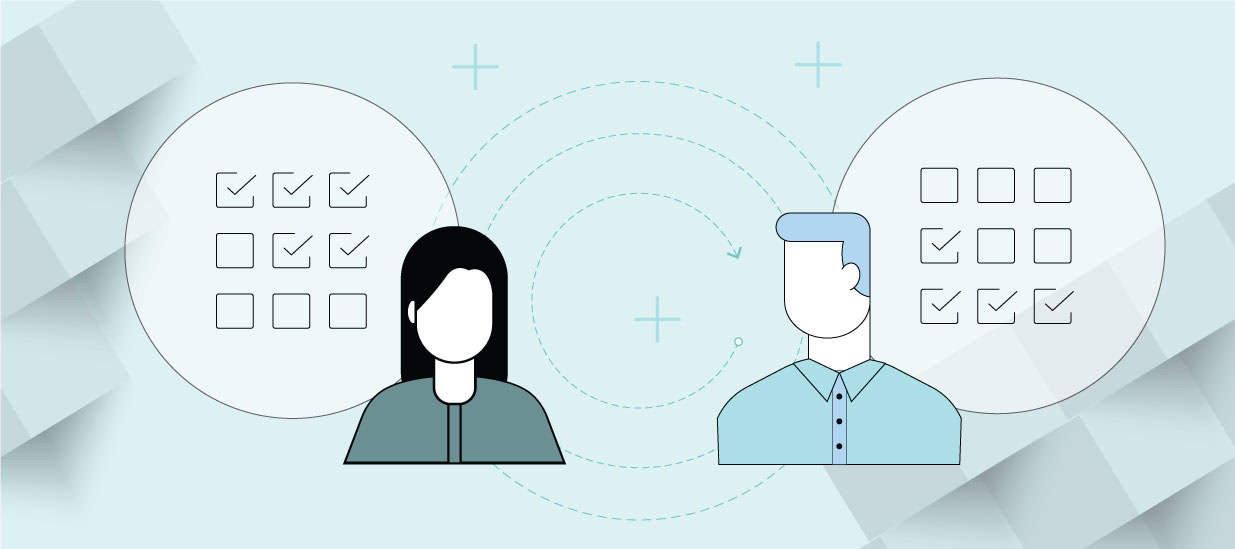9 minute read
Product managers are vital members of any product team. This comprehensive guide explains how to become a product manager, whether you’re an experienced professional or are just beginning your career.
Companies rely on product managers to drive new products, improve existing offerings, and satisfy customers. Product managers are an asset for any business, and demand for qualified product managers continues to grow.
If you’re considering a career in product management, this comprehensive guide has you covered. We share everything you need to become a product manager, from developing your skills, guiding your job search, and starting your career as a product manager (even with no experience)
- What is product management?
- How to become a product manager
- Becoming a product manager with no experience
- Product manager career paths
What is Product Management?
Product management is the job function in an organization that ensures a product’s success by guiding it through its life cycle.
Product management is more than just meeting deadlines and coordinating teams. It guides the product’s vision and strategy while fulfilling the business goals of generating revenue and satisfying customers.
Product management starts with the discovery of market needs, the conceptualization of the product, planning, and product management to guide the product to market. After launch, product management guides the product through maturity and to the end of the product life cycle.
What is a product manager?
A product manager is the person within the organization who leads product management for a specific product. They have the varied skillsets needed to scope a product, coordinate teams to create it on time and within expectations, and continually improve the product throughout its life cycle.
What does a product manager do?
To accomplish this, product managers use data analysis and market research skills to identify market gaps. Then, they develop use cases to create a product to fill those gaps. They also define the product vision and strategy and secure stakeholder buy-in. Ultimately, product managers set product roadmaps and work to keep all teams aligned and moving in the same direction.
Product managers shepherd that product from concept to completion by coordinating with multidisciplinary teams to build, test, and launch the product. They aim to deliver products on time, within budget and aligned with the project scope.
Ultimately, doing so will introduce a product that satisfies existing customers or gains new customers and generates revenue for the business.
How to Become a Product Manager
Good product managers have skill sets specific to product management and transferable from other fields. Product managers can come from almost any background, and the skills you’ve learned in different roles can support your career as a product manager. Let’s explore how you can become a product manager.
Step 1: Learn Product Management Basics
Product managers’ core responsibilities are to identify gaps in the market and deliver profitable products that fulfill those gaps. To do this, aspiring PMs should understand four core product management skills:
- Market Research: Product managers identify customer needs and leverage competitive intelligence to pinpoint gaps in the market that current products can’t satisfy.
- Create Product Roadmaps: Product Roadmaps are the guides that help product managers execute their strategy. They are detailed plans that communicate the direction of your product and illustrate the vision and key phases of deliverables. They should show the “why” behind a product.
- Develop and Guide Product Strategy: A product strategy is a high-level plan that outlines how a product or feature supports a business’s goals. Product managers use this strategic vision to guide a product’s development, launch, and ideation.
- Manage the Product Life Cycle: Product Managers guide their products through all product life cycle stages: development, introduction, growth, maturity, decline, and removal from the market during the product’s end of life.
Understanding these four core skills can help product managers make data-driven decisions, apply best practices to their products, and deliver value for the customer while driving revenue for their company.
Step 2: Develop Hard and Soft Skills
Product management requires business acumen, data skills, project management, customer and user experience insight, and soft skills to deliver a product successfully.
Successful product managers need a variety of skill sets, including hard and soft skills. Hard skills for product managers might include product management methodologies (such as Agile or Scrum), market research, data analysis, product feature prioritization, and project management. Product managers also benefit from soft skills like communication and empathy. Product managers may prioritize some skills over others, depending on what their job requires from them. Overall, hard and soft skills help them become more effective product managers by better understanding customers, collaborating with other teams, aligning strategy to business goals, and bringing products to completion.
Step 3: Build a Portfolio
To land a job, you must demonstrate your new product management skills to prospective employers. A portfolio contains case studies of recent products and projects. It should showcase who you are, highlight your professional background and experience, and demonstrate what makes you a great product manager.
Product management portfolios allow you to create one place to showcase your work. Often, portfolios are hosted on professional websites like Squarespace, WordPress, or Adobe Portfolio. Online portfolios showcase projects or products where you have taken on product management roles or responsibilities. Even if you didn’t have a “product manager” title, this is an opportunity to demonstrate relevant skills and show off your product manager mindset. You can link a product portfolio in your resume and job cover letter on your LinkedIn or provide it personally via email during the application and interview process. Many job seekers link their portfolios in all three places.
Here are some examples of Product Management Portfolios:
- Dan Shetty: Shetty’s portfolio site highlights his background and past roles, seamlessly creating a narrative explaining where he’s been and hopes to go. As a note for anyone changing careers, Shetty highlights that his first degree was in psychology and highlights this as an asset to his PM Career.
- Reza Rezaeipour: Rezaeipour’s product manager portfolio is on a single-page website. This layout highlights his career path in chronological order, and the portfolio section’s visual prominence highlights his most important projects.
Step 4: Get a Product Management Certification
If you’re new to product management or want a leg up in the interview process, consider pursuing a Product Management Certification. Certifications are courses taught by product management experts to equip students with the skills they need to be effective product managers.
Here are some benefits of product management certifications:
- Taught by experts.
- Focus on industry best practices to help you develop hands-on skills.
- Comprehensive coverage of topics with a structured learning path.
- Hands-on learning with independent projects, group discussions, and tangible examples to implement course material.
- Accessible resources (such as product roadmapping templates) you can leverage in your product manager role.
- Expert advice on building portfolios and applying for jobs.
- Connection to networks of product management professionals.
- Certification from a credible, recognized product management entity.
Completing a product management certification shows that you are committed to your career and have gained the skills needed to excel in your role from a trusted educator.
Step 5: Network
Although networking can be intimidating, it is a crucial step to meeting product professionals and landing your first job as a product manager. It creates strong connections with peers in the field, opens the door to new career opportunities, and provides a wellspring of insight and mentorship. If you’re new to networking, here are some simple ways to get started.
- Network in your company. If you are in an unrelated profession, such as marketing or UX design, look to product professionals in your own company! You already have something in common. Explain that you want to learn more about their role within the organization and product in general.
- Tap your professional network. Use tools like LinkedIn or college alum communities to find contacts (or friends of contacts) in product. You’ll be surprised at how many product professionals are just 1 or 2 degrees of separation away from you.
- Leverage Pragmatic’s Alumni Community. Anyone who has taken a Product course with Pragmatic Institute has access to Pragmatic’s Alumni Community, an online community of thousands of product professionals who have completed courses and certifications from Pragmatic. You can connect with product pros eager to offer advice and best practices to industry veterans and new professionals.
Above all, you should network in a way that feels comfortable. Professional events, conferences, and casual mixers are great options for connecting with multiple people. Or, if you want to have a deeper conversation with one person, one-on-one conversations over coffee might be preferable. You can also join professional forums (on Slack, Discord, or Reddit) to chat and connect with other product pros virtually.
Start small and build your network slowly. Having a few quality connections is far better than having many surface-level connections.
Step 6: Apply for a Product Management Job
Once you’ve learned the essential skills to become a product manager, created your portfolio, and built your professional network, it’s time to apply for your first product management job!
Like any other job, you should tailor your resume and cover letter to highlight your relevant experiences and skills for the job you’re applying for. Highlight relevant or transferable skills to support your work in this role or industry. If you are new to product management, your resume and cover letter should demonstrate how you have educated yourself on the role and the field.
You can find product manager job openings on job boards like:
If you want to pursue a role as a product manager within your current company, check with your manager and product team members to discuss potential opportunities and openings. If so, this is an excellent opportunity to break into product because you are already familiar with the organization and industry and have already shown your value to the company.
To break into product management, consider Product Manager roles at small companies or pre-seed startups. You can also explore Associate Product Manager internship programs with companies like Google, Atlassian, or LinkedIn. Another route is to apply for product-adjacent roles like marketing or software development at larger companies. Establish yourself within the company, develop a strong working relationship with the product team, and work with your supervisor to create a career plan to transition into product.
Step 7: Ace the Interview
Remember that professional interviewing guidelines still apply during the interview process regardless of how you land your first interview. Be courteous and positive, and show the work you’ve done to start your career as a product manager.
Before your interview, brush up on common product manager interview questions and answer strategies. After the interview, remember to thank your interviewers for their time via email or a written note. Be sure to send your thank you correspondence within 24 hours of your interview.
Whether you land the job or not, asking for feedback once you’ve received the final decision will help you strengthen your interviewing skills for future positions.
Become a Product Manager With No Experience
New college graduates and professionals from unrelated fields increasingly want to transition into product management. One common question is, “How can I become a product manager with no experience?” The good news is that becoming a product manager without a degree or relevant product experience is possible. Breaking into your first role may take time.
As a rule, candidates with relevant experience or past roles in product will have the upper hand when interviewing for a product management role. Additionally, a joint report from the Burning Glass Institute, The Business-Higher Education Forum, and Wiley found that at all experience levels, workers with product management skills have higher earning potential than workers without product management skills. If you want to begin a career in product, but don’t have any product experience and lack transferable skills, you may need to pursue internships or entry-level titles as you become familiar with the role. Additionally, independently pursuing a product management certification can help you build your product knowledge and make you a valuable addition to a team.
Product Manager Career Paths
If you’re beginning your product career, you might ask, “What is the standard product manager career path?” There is no set way to become a product manager, but we will explore typical milestones.
Education
Most product managers have at least a bachelor’s degree. You will find that almost all product jobs require a bachelor’s degree or college education. However, developing the skills to become a product manager without a degree is possible.
Product manager roles don’t typically require MBAs or other graduate-level business degrees. However, skills you learn in an MBA, such as financial analysis, strategic thinking, and business principles, may lend themselves to product management. When applying for product management roles, highlight relevant skills (and don’t worry if your educational background doesn’t directly match the job description).
Work Experience
About half of product professionals begin in other fields. Since product managers draw on skills from multiple disciplines, including business, finance, marketing, user experience, and software (to name just a few), it’s common for product managers to start in those fields or related roles.
Within product, product marketers, UI/UX experts, designers, engineers, and developers may branch into product management.
Common Product Management Roles
Your career doesn’t stop at becoming a product manager. Here are some common job titles that coincide with a product management career:
- Associate Product Manager (APM)
- Product Manager
- Product Owner
- Product Portfolio Manager
- Senior Product Manager (Sr. PM)
- Director of Product
- Chief Product Officer (CPO)
Key Takeaways + Next Steps
Anyone can be a Product Manager. There is no single path to becoming a product manager; professionals from all backgrounds can start a product management career. Whether you start with formal education, gain relevant work experience in other roles, or develop skills through product management certifications and independent learning, there are multiple entry points into this field.
Aspiring product managers should focus on building robust skill sets that include product skills, technical knowledge, and soft skills like communication and project management. Earning certifications, developing a portfolio of product management work, networking, and honing interview skills can help aspiring candidates find roles.
Ultimately, product management is about bridging the gap between the business, technology, and user. Product managers ensure that products meet customers’ needs and thrive in the market. So, are you ready to become a product manager? Here are some steps to get started.
- Stay current on the latest trends and topics in product management with our live and on-demand webinars.
- Earn a Product Management Certification with our expert-led courses. We’ll equip you with the tools, tactics, and templates you need to make an impact on your first day in your new product management career.
- Check out our free library of Resources for Product Managers.
Author
-

The Pragmatic Editorial Team comprises a diverse team of writers, researchers, and subject matter experts. We are trained to share Pragmatic Institute’s insights and useful information to guide product, data, and design professionals on their career development journeys. Pragmatic Institute is the global leader in Product, Data, and Design training and certification programs for working professionals. Since 1993, we’ve issued over 250,000 product management and product marketing certifications to professionals at companies around the globe. For questions or inquiries, please contact [email protected].
View all posts








